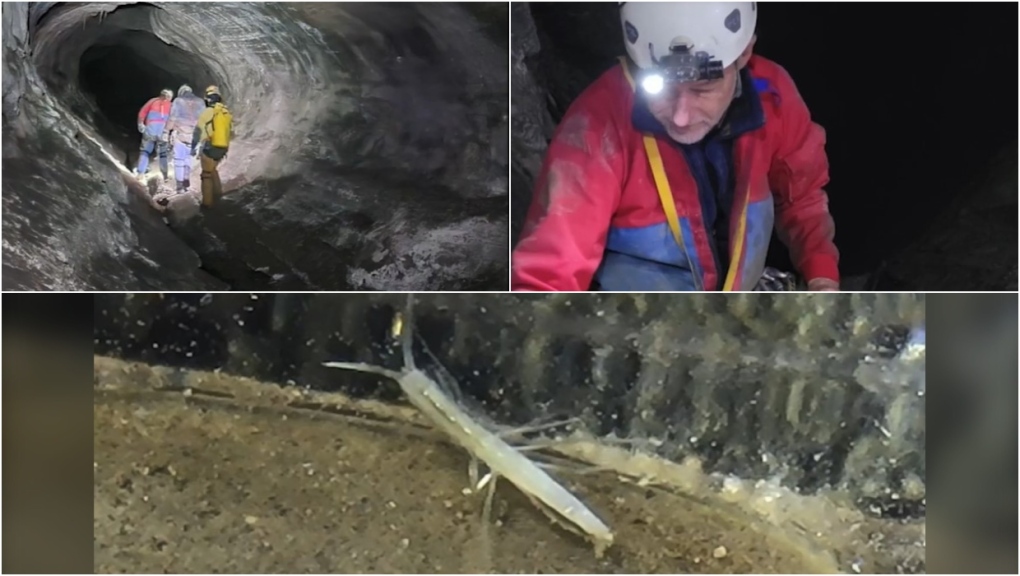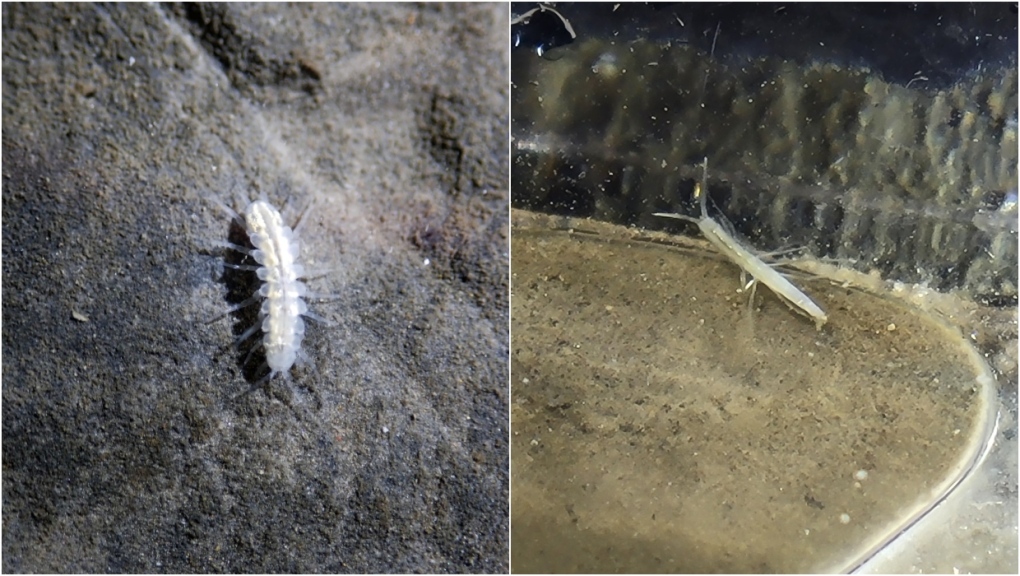Banff National Park cave creature exists 'no where else': Parks Canada
 A cave in Banff National Park has been recognized as a globally significant Key Biodiversity Area (KBA) thanks to the freshwater amphipod crustacean found inside. (KBA program)
A cave in Banff National Park has been recognized as a globally significant Key Biodiversity Area (KBA) thanks to the freshwater amphipod crustacean found inside. (KBA program)
A cave in Banff National Park has been recognized as a globally significant location thanks to a tiny creature found inside.
The freshwater amphipod crustacean, known as the Castleguard Cave amphipod (Stygobromus canadensis), is largely transparent and looks like a miniscule shrimp, but it's hugely important.
"This tiny cave-dwelling organism is only found in Castleguard Cave, and no where else on the planet," said Anne Forshner, Parks Canada species of concern ecologist.
It's because of the amphipod that Castleguard Cave has recognized as a Key Biodiversity Area (KBA).
"Scientists still don’t know a great deal about this particular amphipod, which has somehow survived for millennia in this cold, nutrient poor and frequently flooded environment, but its uniqueness made this site a prime candidate for KBA status," said Parks Canada in a news release.
 A cave in Banff National Park has been recognized as a globally significant Key Biodiversity Area (KBA) thanks to the freshwater amphipod crustacean found inside. (Wildlife Conservation Society Canada)Located in the north end of Banff National Park, Castleguard Cave is a limestone cave that features one Canada's longest known cave systems – 21 kilometres in length.
A cave in Banff National Park has been recognized as a globally significant Key Biodiversity Area (KBA) thanks to the freshwater amphipod crustacean found inside. (Wildlife Conservation Society Canada)Located in the north end of Banff National Park, Castleguard Cave is a limestone cave that features one Canada's longest known cave systems – 21 kilometres in length.
"Castleguard Cave itself is a unique environment," said Forshner. "Part of the cave exists underneath the glaciers that form the Columbia Icefields, and while there is much research into glaciers, cave ecology in this part of North America is poorly understood."
The cave is located about 170 kilometres north of the Cave and Basin Historic Site.
Castleguard Cave joins two other sites in Alberta recognized by the KBA program – the Frank Lake wetland near High River, Alta. and the Peace-Athabasca Delta in northeast Alberta.
The KBA program works with governments, local conservation organizations, scientists and Indigenous Nations to collaboratively identify the places that are most critical to conserve to avoid losing a species or ecosystem.
Sites are recognized based on meeting strict criteria.
While KBAs are not designed to provide any legal protection, they are a way of identifying places in unprotected areas where conservation and stewardship efforts can have a large impact on halting and reversing the loss of nature.
More than 70 sites across Canada are listed as KBAs and more than 850 more under consideration.
To learn more you can visit the KBA Canada website.
CTVNews.ca Top Stories

'Mayday! Mayday! Mayday!': Details emerge in Boeing 737 incident at Montreal airport
New details suggest that there were communication issues between the pilots of a charter flight and the control tower at Montreal's Mirabel airport when a Boeing 737 made an emergency landing on Wednesday.
Trudeau appears unwilling to expand proposed rebate, despite pressure to include seniors
Prime Minister Justin Trudeau does not appear willing to budge on his plan to send a $250 rebate to 'hardworking Canadians,' despite pressure from the opposition to give the money to seniors and people who are not able to work.
Hit man offered $100,000 to kill Montreal crime reporter covering his trial
Political leaders and press freedom groups on Friday were left shell-shocked after Montreal news outlet La Presse revealed that a hit man had offered $100,000 to have one of its crime reporters assassinated.
Cucumbers sold in Ontario, other provinces recalled over possible salmonella contamination
A U.S. company is recalling cucumbers sold in Ontario and other Canadian provinces due to possible salmonella contamination.
Trudeau says no question incoming U.S. president Trump is serious on tariff threat
Prime Minister Justin Trudeau says incoming U.S. president Donald Trump's threats on tariffs should be taken seriously.
John Herdman resigns as head coach of Toronto FC
John Herdman, embroiled in the drone-spying scandal that has dogged Canada Soccer, has resigned as coach of Toronto FC.
Billboard apologizes to Taylor Swift for video snafu
Billboard put together a video of some of Swift’s achievements and used a clip from Kanye West’s music video for the song “Famous.”
In a shock offensive, insurgents breach Syria's largest city for the first time since 2016
Insurgents breached Syria's largest city Friday and clashed with government forces for the first time since 2016, according to a war monitor and fighters, in a surprise attack that sent residents fleeing and added fresh uncertainty to a region reeling from multiple wars.
Canada Bread owner sues Maple Leaf over alleged bread price-fixing
Canada Bread owner Grupo Bimbo is suing Maple Leaf Foods for more than $2 billion, saying it lied about the company's involvement in an alleged bread price-fixing conspiracy.


































